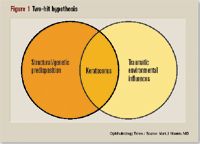Article
Keratoconus a 'two-hit' phenomenon, studies suggest
Keratoconus appears to be a "two-hit" phenomenon, a genetic predisposition propelled by external factors to result in damage to the cornea.

Key Points

"We have not solved the mystery of keratoconus, but like a jigsaw puzzle, we are moving piece by piece to reveal the picture," he said, offering a summary of and commentary on research into the condition.
"The peculiar-and presumably genetically determined-abnormalities in the structure and biochemistry of the keratoconic cornea are amplified by the presence of external trauma-such as atopy, contact lens wear, and eye-rubbing-that produces damage leading to apoptosis, loss of tissue, and scarring," said Dr. Mannis.

"We know in large part that it occurs in all ethnic groups, with somewhat greater frequency in south Asian populations. We are aware of its usual clinical onset at puberty and of its arrest by the fourth decade," Dr. Mannis said, adding that the condition predominantly occurs in men.
"And we now know, through the employment of topography, that it is much more common topographically than clinically," he added.
Because ophthalmologists see the disorder relatively infrequently, and because its onset and diagnosis are gradual, Dr. Mannis continued, mild cases often go undetected unless discovered through topography. "[Those characteristics make] population-based surveys of prevalence very difficult and, presumably, inaccurate," he said.
Most cases isolated
Although keratoconus often is associated with other diseases, most cases are isolated and are not connected to systemic abnormalities, Dr. Mannis said.
"There's been great interest in determining if keratoconus is associated with shortened life expectancy as a more general manifestation of connective tissue abnormality. This has not proven to be true," he added.
Keratoconus has been reported in a long list of ocular abnormalities in the literature but usually is encountered with atopic disease, Dr. Mannis said. He also named Down syndrome, contact lens wear, Leber's congenital amaurosis, eye-rubbing, and disorders involving increased collagen fragility as examples.
"The common feature here is external trauma," he said. "Of these, the strongest and clearest associations are with atopy and Down syndrome."
Eye-rubbing, a form of chronic trauma, was the only significant predictor of keratoconus in a case-controlled, multivariate analysis involving 120 patients, Dr. Mannis noted (Bawazeer AM, Hodge WG, Lorimer B. Atopy and keratoconus: a multivariate analysis. Br J Ophthalmol. 2000; 84:834-836).





